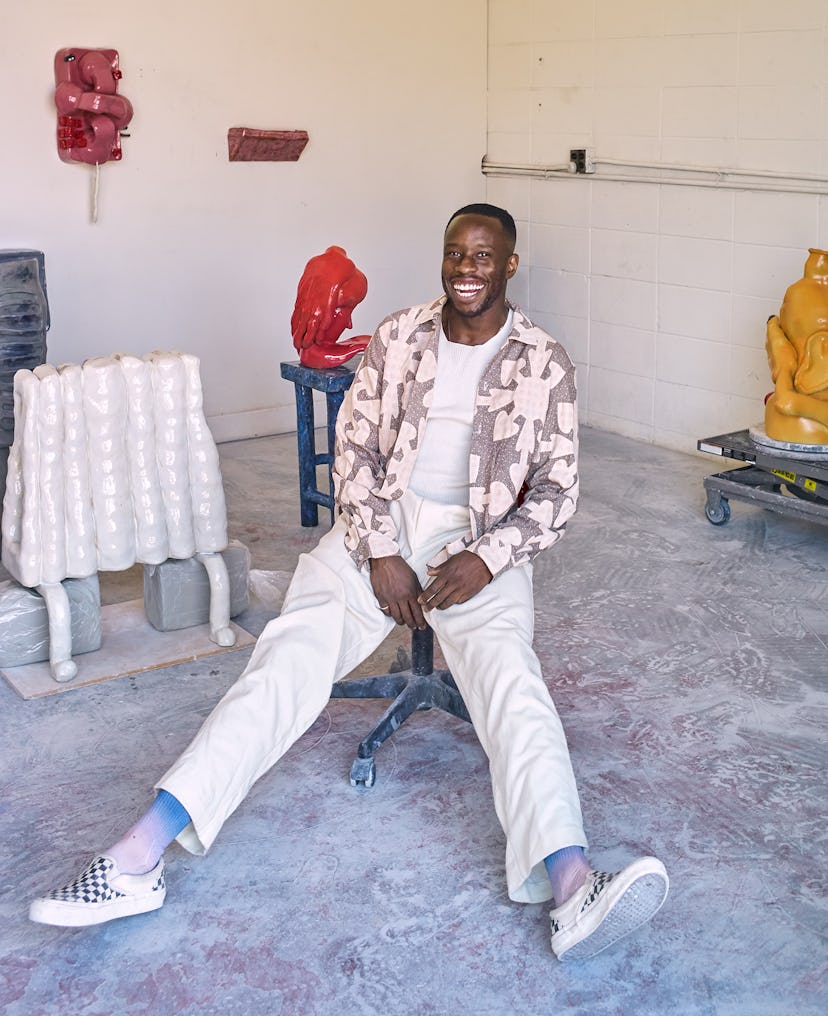
The artist Woody De Othello is a CrossFit devotee, so it’s hardly surprising that his work, too, is extremely physical. He makes large, intentionally clumsy ceramic sculptures that emulate and distort household furniture—stools, lamps, nightstands, and urns—and oversize appliances, like a wall-mounted telephone with a glossy red tongue for a receiver. It’s a theme he began four years ago while at the California College of the Arts, in San Francisco, where he made “a big-ass neti pot” based on the one he used for his persistent allergies. “I was in this mind-set of anthropomorphizing everyday objects,” De Othello, who is now 28, says. “I made the big pot with a fingernail at the end of it to reference picking your nose. If it makes me giggle, I’ll try to make it.”
For De Othello, who was born in Miami to Haitian immigrants, the California dream had less to do with beaches, surfing, Pilates, and kale Caesar salad than with ceramics artists. “Peter Voulkos, Robert Arneson, Viola Frey, Ron Nagle, Ken Price—all West Coast,” he says. “I’m in better conversation with their work in California than in South Florida. I had this vision of living somewhere, but I didn’t know where it was. The longer I’m here, the more I realize it was the Bay Area. It’s what I was dreaming of.” He currently works out of a one-story stucco building in El Cerrito, an endearingly retro suburb just north of Berkeley. There’s a modest kiln behind the metal roll-up door, and an assistant, a friend from school, helps him roll out clay on a press to make table legs for a new piece to be featured in a solo show at the San José Museum of Art. The space is smaller than you might expect for the ambitious scale of the work.
*De Othello’s Space Heater*, 2019.
In 2017, as De Othello was completing his MFA studies, the gallerist Jessica Silverman, who is now his dealer, discovered him at a school-sponsored open studios event where he was showing various sculptures, including a yellow ceramic cat scratching post and that neti pot. She had to pinch herself not to offer him an exhibition on the spot. “He had an infectious spark—and his work looked so different than other ceramics,” Silverman recalls. She brought him to the Armory Show in Manhattan that same year, signed him on a few months later, and hosted an ambitious solo show in the fall of 2018. He was subsequently picked up by Karma in New York, where he had another solo show this past summer.
Barely out of school, De Othello has participated in the Front International: Cleveland Triennial for Contemporary Art; the 33rd Ljubljana Biennial of Graphic Arts, in Slovenia; and the Bay Area Now 8 show, at San Francisco’s Yerba Buena Center for the Arts. He also created a series of bronze sculptures of stretched, intertwined body parts and surrealistically melting clocks for the San Francisco International Airport. For all of his achievements, he says he was especially pleased to be included in Art Basel Miami Beach last year. His parents still live in Florida, and he visits them often and calls them multiple times a week. “I’ve always, always dreamed of being at that fair,” he says. “All my family got to come see my work. That was so cool.” He’ll be in Miami again in December, with a new eight-foot-tall bronze fan, which the artist describes as exploring “the conceptual history of breathing.”
The artist’s studio, in a former auto-repair shop.
Like his enormous fan, De Othello says, his lumpy HVAC sculptures, which he presented in his first solo show, reference air quality, and “thinking about my body taking a breath.” They are also about the bodies of Africans who were brought to the Caribbean and worked to death. And about Eric Garner’s last words, “I can’t breathe.” “I wanted to do something subtle, where if you didn’t have that train of thought, you could look at that AC unit as a formal thing. It’s weird, its center is sunken, it’s having a hard time. Imagine what it would sound like if it were an actual working thing? I like to think that a lot of the stuff I make is a catharsis,” he says. “They’re like vessels to place our bad juju. Put it in this thing, let this object have it so we can go about with more lightness and openness.”